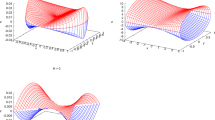Abstract
A two-point model of an unisolated star cluster moving in a circular orbit in the Galactic plane is analyzed. The equations of stellar motion are linearized in the neighborhood of the singular point at the zero-velocity surface (ZVS), and also in the neighborhood of a point below the critical ZVS on a trajectory with less than the critical stellar ‘energy.’ We find the eigenvalues and eigenvectors of these equations and point out the instability of the two singular points on the critical ZVS; the separatrix connecting these points is determined numerically. For trajectories located below the critical ZVS, the absolute values of the eigenvalues of the linearized equations of motion increase with decreasing energy of the star and decreasing maximum distance between the trajectory and the cluster center of mass. This results in an increase of the numerical estimates of the maximum characteristic Lyapunov exponents for trajectories located closer to the center of mass of the cluster. We use Poincaré sections and the maximum characteristic Lyapunov exponents to analyze the properties of the stellar trajectories. A number of periodic orbits for different stellar energies are found, and the properties of the trajectories in the vicinity of these periodic orbits analyzed. Almost all the stellar trajectories considered are stochastic, with the degree of stochasticity increasing with decreasing stellar energy. Domains with different degrees of stochasticity are identified in the Poincaré maps.
Similar content being viewed by others
References
V. M. Danilov and E. V. Leskov, Astron. Zh. 82, 219 (2005) [Astron. Rep. 49, 190 (2005)].
V. M. Danilov, Astron. Zh. 82, 678 (2005) [Astron. Rep. 49, 604 (2005)].
B. J. Bok, Harvard Obs. Circ. 384, 1 (1934).
H. Mineur, Ann. Astropys. 2, 1 (1939).
V. M. Danilov, Astron. Zh. 83, 393 (2006) [Astron. Rep. 50, 346 (2006)].
V. M. Danilov and L. V. Dorogavtseva, Astron. Zh. 80, 526 (2003) [Astron. Rep. 47, 483 (2003)].
M. Gidea and J. J. Masdemont, http://www.mal.upc.edu/recerca/reportstre/02/rep0203ma...
L. V. Vela-Arevalo and J. E. Marsden, Class. Quant. Grav. 21, 351 (2004).
O. C. Winter and E. Viera Neto, Astron. Astrophys. 377, 1119 (2001).
M. E. Paskowitz and D. J. Scheeres, J. Guid., Control Dyn. 29, 342 (2006).
S. Chandrasekar, Principles of Stellar Dynamics (Univ. Chicago, Chicago, 1942; Inostr. lit-ra, Moscow, 1948).
I. R. King, An Introduction to Classical Stellar Dynamics (Berkeley, 1994; URSS, Moscow, 2002).
L. Spitzer, Jr., Dynamical Evolution of Globular Clusters (Princeton Univ. Press, Princeton, 1987; Mir, Moscow, 1990).
G. A. Korn and T. M. Korn, Mathematical Handbook for Scientists and Engineers (McGraw-Hill, New York, 1961; Nauka, Moscow, 1968).
S. A. Kutuzov and L. P. Ossipkov, Astron. Zh. 57, 28 (1980) [Sov. Astron. 24, 17 (1980)].
A. P. Markeev, Libration Points in Celestial Mechanics and Cosmic Dynamics (Nauka, Moscow, 1978) [in Russian].
V. V. Nemytskii and V. V. Stepanov, Qualitative Theory of Differential Equations (Gostekhizdat, Moscow, 1947; Princeton Univ. Press, Princeton, N.J., 1960).
G. J. Contopoulos, Order and Chaos in Dynamical Astronomy (Springer, Berlin, 2002).
F. R. Gantmacher, The Theory of Matrices (Nauka, Moscow, 1966; Chelsea, New York, 1959).
A. Yu. Loskutov and A. S. Mikhailov, An Introduction to Synergetics (Nauka, Moscow, 1990) [in Russian].
V. A. Yakubovich and V. M. Starzhinskii, Lineinye differentsial’nye uravneniya i ikh prilozheniya (Linear Differential Equations and their Applications) (Nauka, Moscow, 1972) [in Russian].
B. P. Demidovich, Lektsii po matematicheskoi teorii ustoichivosti (Lectures on Mathematical Theory of Stability) (Nauka, Moscow, 1967) [in Russian].
A. J. Lichtenberg and M. A. Lieberman, Regular and Stochastic Motion (Springer, New York, 1982; Mir, Moscow, 1984).
R. Wielen, Astrophys. Space Sci. 13, 300 (1971).
Author information
Authors and Affiliations
Additional information
Original Russian Text © V.M. Danilov, O.A. Chernova, 2008, published in Astronomicheskiĭ Zhurnal, 2008, Vol. 85, No. 1, pp. 32–45.




